#Dyscophus
Note
Hello! Can I request some images of tomato frogs from Madagascar?
Yes, absolutely, lets have a look at the 3 species.
Also, have a look at some previous posts:
Herps and Birds (and More) (Posts tagged dyscophus) (tumblr.com)

Madagascar Tomato Frog (Dyscophus antongilii), family Microhylidae, Madagascar
photograph by boogerbear4g
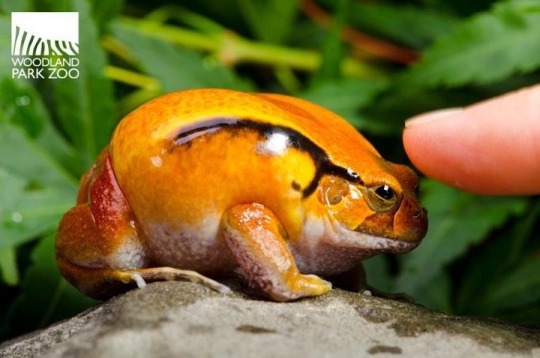
Sambava Tomato Frog (Dyscophus guineti), family Microhylidae, found in central Madagascar
photograph by Woodland Park Zoo
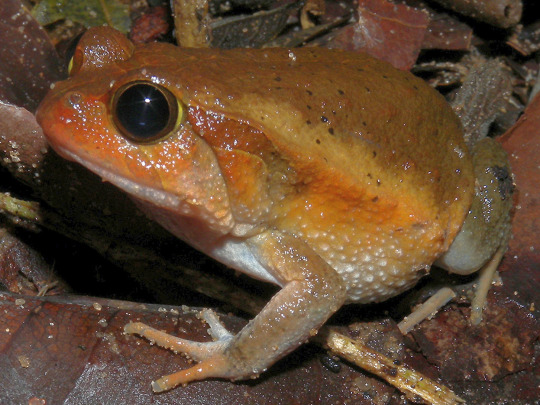
Antsouhy Tomato Frog (Dyscophus insularis), family Microhylidae, found in western Madagascar
photograph by Frank Vassen
986 notes
·
View notes
Text
Madagascar Tomato Frog

AKA Dyscophus antongilii
Red as a tomato! These frogs are only found in northern Madagascar, and are closely related to the false tomato frogs from the same country (I wonder if they have a family rivalry).
The girls are redder and bigger, up to 4.13 inches, while the boys barely get half as big. They're from the Narrow-Mouthed frog family, which tend to be smaller, but these are a bit bigger.
They can live in forests, swamps, and ponds, but their habitats are being degraded and polluted, and some end up living in cities.
While frogs are mostly known for eating flies, these even ambush and eat beetles! That's a tomato for you.
#frogs#narrow-mouthed frogs#red frogs#madagascar tomato frog#tomato frogs#dyscophus antongilii#african frogs
12 notes
·
View notes
Text
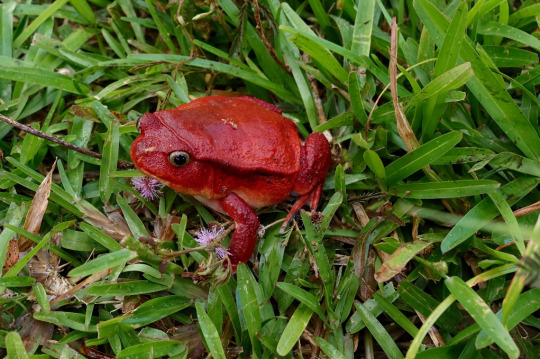
Tomato Frog (Dyscophus antongilii)
Family: Narrowmouth Frog Family (Microhylidae)
IUCN Conservation Status: Least Concern
Named for their rotund red bodies, Tomato Frogs are endemic to Madagascar where they are mostly found in wet, well-vegetated environments in the northeast. Spending the day buried beneath damp soil or leaf litter to avoid predation and dehydration, members of this species emerge at night to hunt for beetles, flies and other terrestrial arthropods, and respond to threats from nocturnal predators by inflating their bodies to appear larger and secreting a thick, sticky and mildly irritative substance from their skin, making them difficult for predators to bite or grab. Tomato Frogs breed following periods of heavy rainfall, and like almost all frogs they lay their eggs in water; males, which are smaller and paler than females, gather around suitable ponds or slow-moving rivers and streams during the night and produce low, quiet, grumbling calls, competing for the attention of females. If a female selects a male she will allow him to cling to her back and will carry him around for an extended period as she lays over 1,000 soft, transparent eggs which he fertilizes externally. Shortly after fertilization the eggs hatch into tiny, limbless, fully aquatic tadpoles that gradually develop limbs and lungs over the course of several months - after transitioning to life on land young Tomato Frogs are initially dull brown or pale yellow, gradually developing a redder colouration until they reach full maturity at 2-3 years of age.
------------------------------------------------
Image Source: Here
#tomato frog#Tomato Frog#frog#frogs#amphibian#amphibians#zoology#biology#herpetology#wildlife#African wildlife#herpetofauna
184 notes
·
View notes
Text
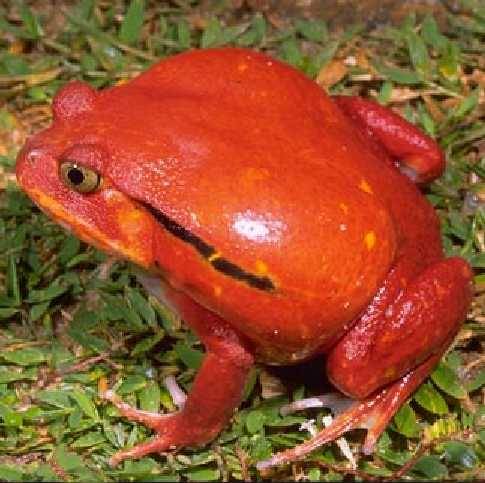
Madagascar Tomato Frog (Dyscophus antongili) Least Concern (but still a special boy). Image credit: Franco Adreone under CC BY-SA 2.5
Alt text: a frog that looks like a real a-spicy meatball, red and chubby with yellow eyes.
106 notes
·
View notes
Text
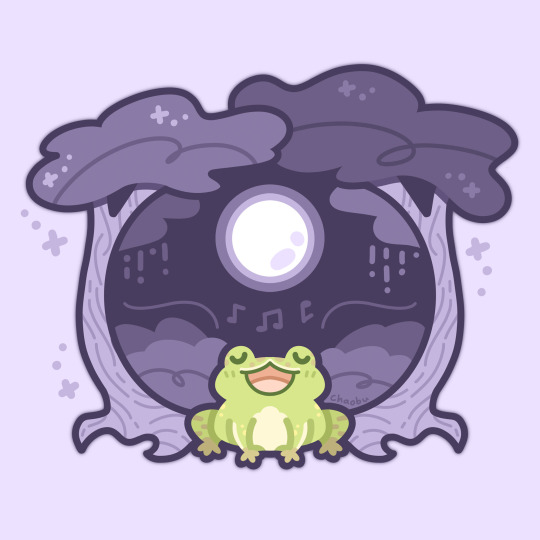







Froggy fall! (part 2/3)
9. Spooky forest / Barking tree frog (Dryophytes gratiosus)
10. Hanging ivy / Red-backed poison frog (Ranitomeya reticulata)
11. Candle / Golden mantella (Mantella aurantiaca)
12. Stones + gems / Coronated tree frog (Triprion spinosus)
13. Tea / Amazon milk frog (Trachycephalus resinifictrix)
14. Night sky / Desert rain frog (Breviceps macrops)
15. Harvest / Madagascar tomato frog (Dyscophus antongilii)
16. Plant shelf / American bullfrog (Lithobates catesbeianus)
728 notes
·
View notes
Text
Uncharismatic Fact of the Day
Though they look and sound tasty, tomato frogs are not edible. When threatened, the three members of the genus Dyscophus secrete a gummy substance the numbs the eyes and mouth, forcing predators to abandon their meal. This toxin can also cause allergic reactions in humans, although it is not fatal.

(Image: A delicious-looking Madagascar tomato frog (Dyscophus antongilii) by John White)
If you like what I do, consider leaving a tip or buying me a kofi!
253 notes
·
View notes
Text



The Tomato Frog
(Dyscophus antongilii) - native to the tropical rainforests of northeastern Madagascar. It’s coloration serves as a warning sign. When threatened, the tomato frog secretes a white, glue-like substance from its skin, which serves as a deterrent to predators.
#FBTMN#i made this#FROG#tomato frog#frog jewelry#goblincore#frogs#frogcore#critters#nature#cottagecore#handmade jewelry#resin jewelry#ribbit#frog pendant#Nature inspired jewelry
87 notes
·
View notes
Text

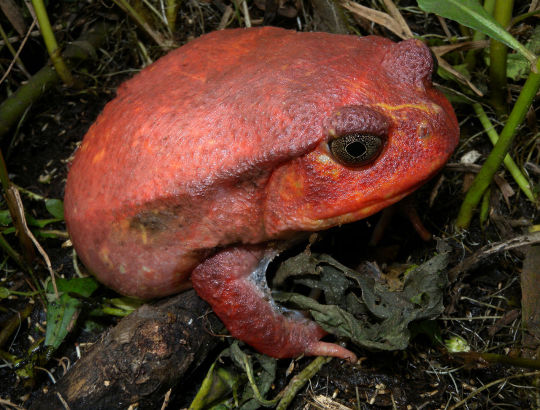
Pumpkin Toadlet: These tiny, toxic frogs lay their eggs on the ground, which then hatch directly into froglets. They also have fluorescent bones, which glow under UV light! It was once predicted that this was warning of their toxicity, but this seemed to have no effect on predation levels, so it is unlikely. Instead, it may be used in mating since their underdeveloped ears are unable to hear their own calls and they mostly rely on visual cues in their place.
Tomato Frog: While all three members of the Dyscophus genus are commonly referred to as tomato frogs, D. antongilli is certainly the most tomato-like in appearance. When threatened, they will puff up to appear larger. If this doesn’t work, they then secrete a thick liquid meant to irritate a predator’s eyes and mouth, which can cause swelling in humans. In part due to the wild-caught pet trade, these frogs are classified as Near Threatened. However, captive breeding efforts have been largely successful and they are unlikely become endangered any time soon.
27 notes
·
View notes
Text
Bishops of the Old Faith Possible IRL Animal Counterparts
None of these are definitive, just my own interpretation of the Bishops and TOWWs possible real world animal counterparts. These assumptions are based purely on appearances alone save a few.
Narinder
Bobtail Maltese
Chartreux; Russian Blue; British Shorthair

Maltese refering to his grey coloration.
I find it funny that some people could not immediately ID TOWW as a cat. His ears bug me, they're too narrow. Actual cats exist in game so maybe those feature are unique to TOWW.
I specify bobtail because we never see him with a tail, as a god or follower. Cats in this universe have tail, see Forneus, but Narinder doesn't appear to have one. If Aym and Baal are his children then they may have inherited this trait from him too.

These are Narinder's sons. I don't care what massive monster may say in the future. They stole his whole FACE. They inherited his coat color! IDC! Forneus genes didn't stand chance.
Leshy
Bagworm

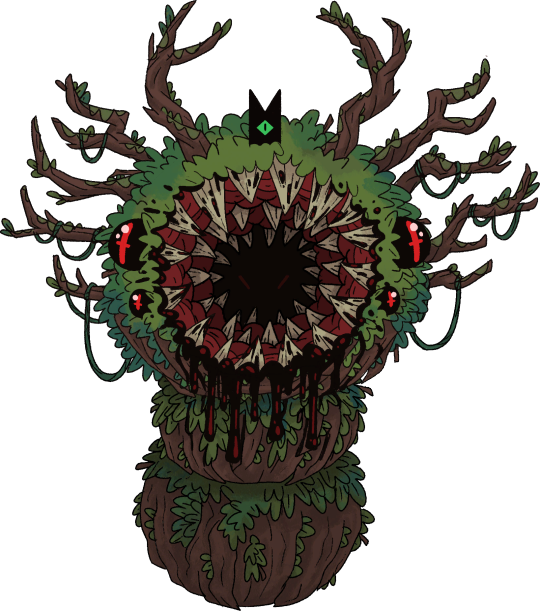
Specifically a juvenile male that hasn't metamorphosed into a moth/butterfly. Only males leave the "bag". The Bishops are implied to be immortal so, maybe he is trapped in this stage because he literally cannot age and develop into a moth...
It's difficult to determine what species of bagworm he is because of the many species of bagworm and their preferred bag material. You can see his true face in his 'mouth' when he transforms, if that's a face, that is. There seems to be some eldritch nonsense going with his physiology.
Heket
Madagascar Tomato Frog

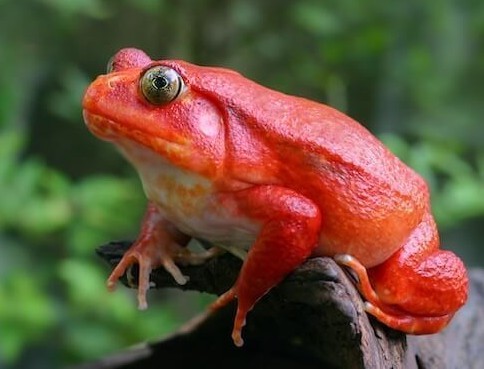
Visually she resembles a Madagascar tomato frog, specifically Dyscophus antongilii, with her bright orange-red back and legs with a pale tan underbelly. Tomatoes frogs secrete a gummy toxin that numb the eyes and mouth of predators when grabbed.
Shamura (Shammuramat)
Jumping Spider


Shamura's eye arrangement identifies them as a type of jumping spider, if not by their jumping attacks in combat.
Like leshy, it's hard to determine what specific species of jumping spider they are because of the numerous species and the vagueness of shamura's design. Even then, I speculate that they could a member of the Portia genus of jumpers. Portias are considered to be the most intelligent spider species due to their adaptive learning and hunting tactics, being able to plan ahead.
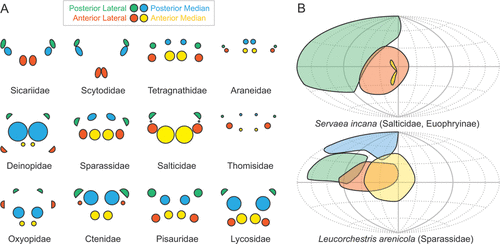
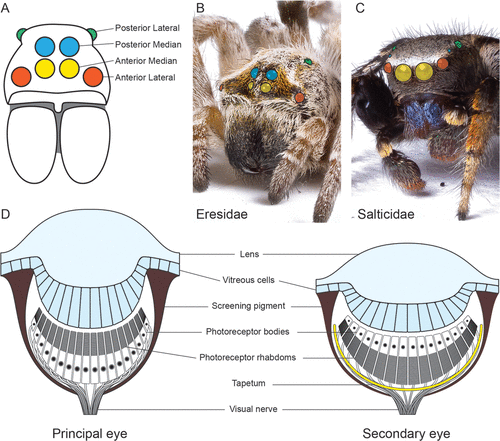
I might expand on these later, and add Haro and Kallamar(maybe), especially Narinder cause I love cats!
#cult of the lamb#cotl#cult of the lamb theory#my post#cotl narinder#cotl heket#cotl shamura#cotl leshy#bishops of the old faith#minus Kallamar#cotl worldbuilding#cult of the lamb worldbuilding
19 notes
·
View notes
Note
Frog time
Today’s frog is
🥁🥁🥁BDRDBRDBRBDBDBRBDBRBRBDBRBDBRBDBRBRBR🥁🥁🥁
The Madagascar tomato frog
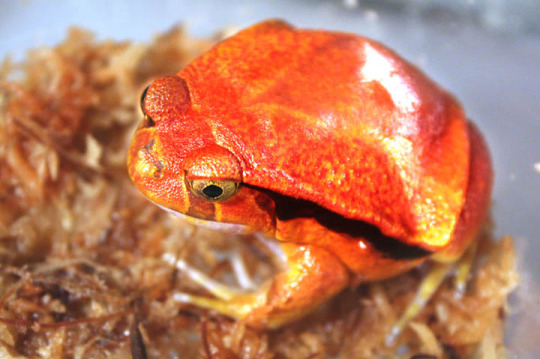
The Madagascar tomato frog(Dyscophus antongilii), is a species of frog native to Madagascar and lives in subtropical or tropical moist lowland forests, rivers, swamps, and freshwater marshes, and is found at altitudes from sea level up to around 200 metres.

Females have a snout-to-vent length 8.5 cm(3.3 in) to 10.5 cm(4.1 in)long, males are slightly shorter coming in at 6 cm(2.4 in) to 6.5 cm(2.5 in). The colouration of antongilii is usually vibrant orange-red, with females having brighter shades of orange or red on their back and a pale underbelly. Some individuals may have black spots on their throats.
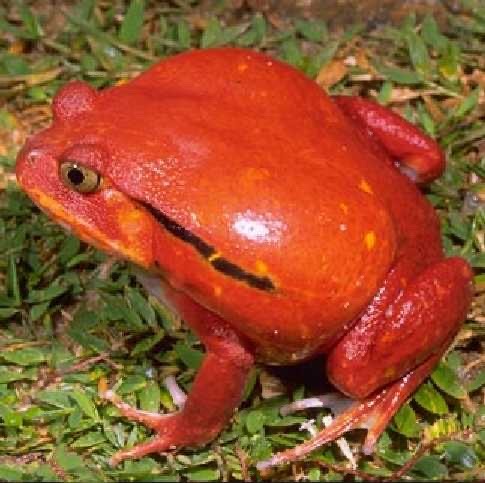
The Madagascar tomato frog has an IUCN Red list rating of nearly threatened.
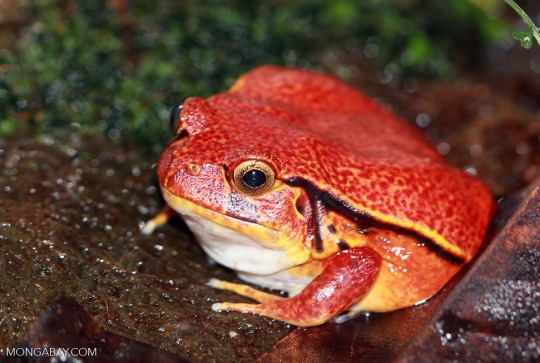
Endemic to Madagascar, The tomato frog is found in the northeastern part of the island around Antongil bay(that’s where the species name comes from), and south to Andorato. The exact distribution of antongilii is unclear because it gets confused with the closely related D. Guineti
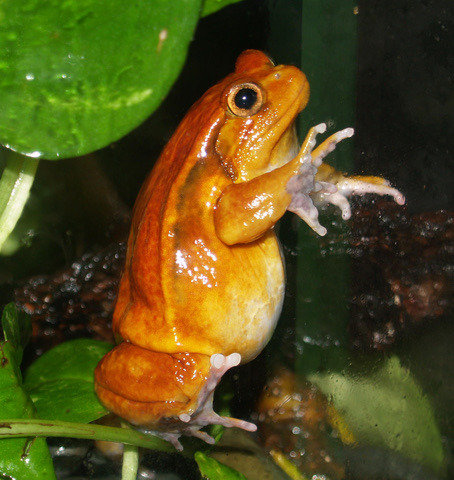
The tomato frog breeds in shallow pools, swamps, and areas of slow-moving water, and they breed following rainfall starting in February until march and usually lay eggs in groups of 1,000 to 1,500.

This has been your spontaneous frog dossier (sorry i took almost a year i forgot i had tumblr)
Sincerely
Thē
I also forgot about Tumblr and Discord for a while Don't worry!
but thank you for the frog time! I always love them sm!!!
2 notes
·
View notes
Text
0 notes
Text
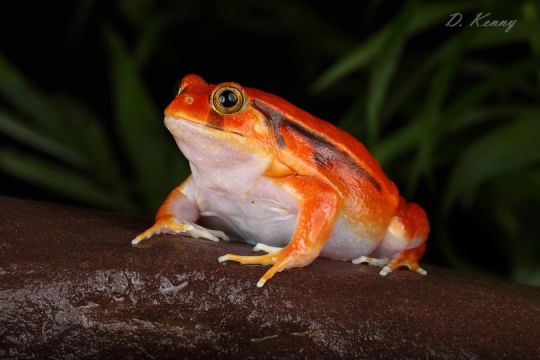
Madagascar Tomato Frog (Dyscophus antongilii), family Microhylidae, Madagascar
photograph by @PhotoDKNJ
788 notes
·
View notes
Text
29 6L.O
La période de la Fête des Etoiles est passée. Je ne comprends pas pourquoi elle rend les gens heureux.
Quand je suis rentrée, les rayons de lune était parallèles au carrelage de la cuisine.
Wyznhort reste avec moi cette nuit. Il sait que l'idée tourne en boucle dans ma tête. C'est difficile. Je compte.
Je n'arrive plus à sortir. Il y a des matins ou j'entend le chant du rouge-gorge, mais je ne bouge pas. Je me dis: "pourquoi ?". Dans ces moments, ma spirale prend la pire des directions, et je tombe dans mes propres draps.
Je suis allé à la cueillette des giroles, et quand j'en ai trouvé sous une litière de feuilles, ça ne faisait plus comme avant. Pareil quand je pêche un beau poisson.
J'ai gouté ce qu'il y avait dans le vase. J'ai vomi. Ce n'est pas fait pour une Kympwyb-Kympwyb.
Dyscophus antongilii (coup de chance)
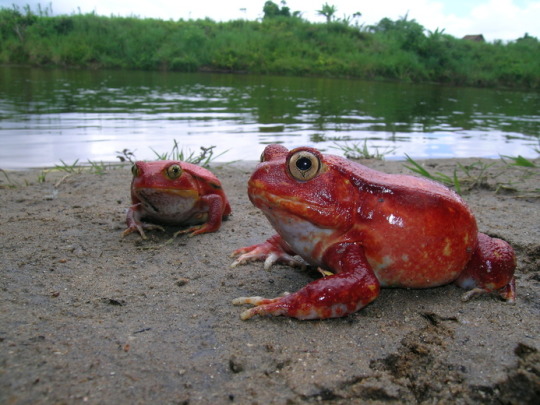
0 notes
Photo
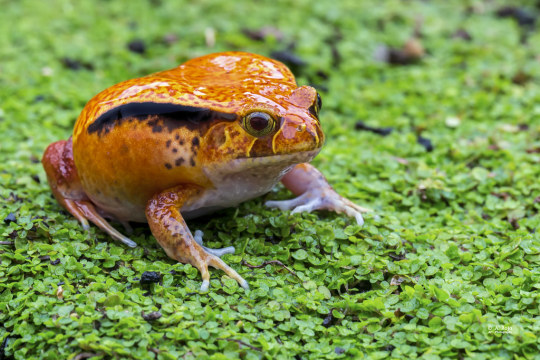
Dyscophus guineti by Antonio Rojo
#Anura#Microhylidae#Dyscophus#Dyscophus guineti#frog#frogs#animal#animals#biology#nature#wildlife#amphibian#amphibians#zoology#herpetology#herps#fauna#critter#critters
261 notes
·
View notes
Text
Tomato Frog
Tomato Frogs are any of the three species of genus Dyscophus: D. antongilii, D. insularis, D. guineti. Dyscophus is the only genus in subfamily Dyscophinae.
They are endemic to Madagascar (which is off the coast of Africa).
Adult Tomato Frogs are larger than a persons fist and males usually grow to about 2 and a half inches and females usually grow to about 3-4 inches.
The frogs habitat is being deforested but they can apparently adapt to living in cultivated areas and found in gardens and eucalyptus plantations.
They breed during rainy season in stagnant or very slow-moving water.
Dyscophus antongilii are in danger due to deforestation and over-collecting for pet trade (poaching), they are protected under CITES (convention on international trade in endangered species) and are illegal in trade.
In short: chonky frog bois
Dyscophus antongilii:

Dyscophus insularis:
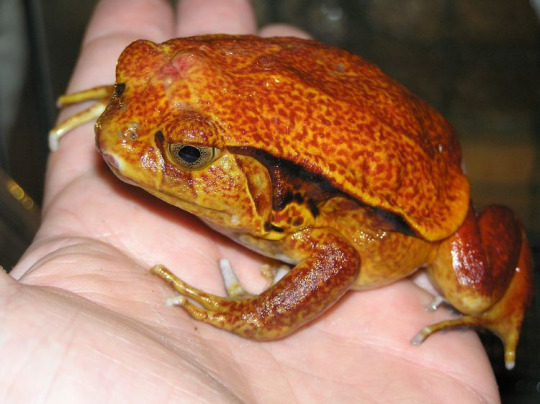
Dyscophus guineti:

#jamesandfrogs#dyscophus guineti#dyscophus insularsis#dyscophus antongilii#tomato frog#frogs#chonky frog#chonky bois#chonky#what a chonk#dyscophus#madagascar
4 notes
·
View notes
Photo

This stunning bright red tomato frog (Dyscophus sp) was photographed by Beverly Houwing at a museum in Santa Ana, California. Tomato frogs get their names by being rotund, large, and red.
191 notes
·
View notes